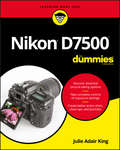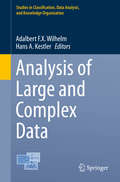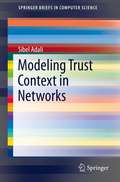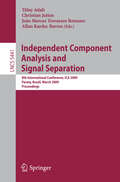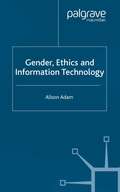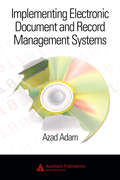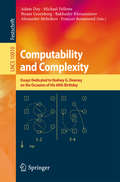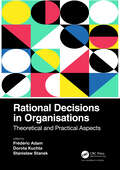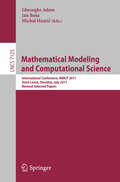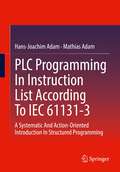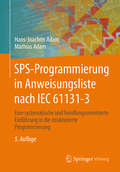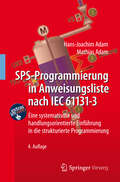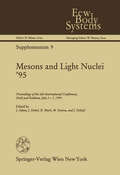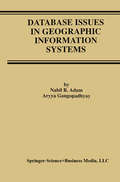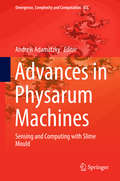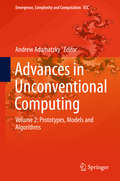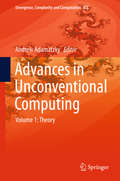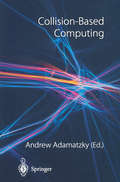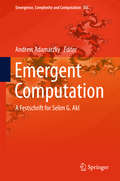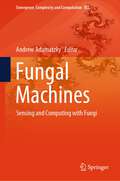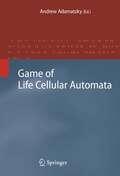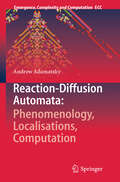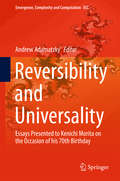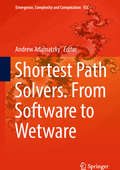- Table View
- List View
Nikon D7500 For Dummies
by Julie Adair KingYour guide to capturing that perfect shot The Nikon D7500 has created a buzz in the photography community, gaining recognition for its appealing combination of high-end features and compact size. If you’re upgrading your existing dSLR or even purchasing your very first camera, Nikon D7500 For Dummies will help you feel like a pro in no time. This book highlights the importance of understanding all of the basic features of your new camera, before diving into insights about how to take top-notch photos. You’ll learn about when and how to use flash, understand exposure, and control focus and depth of field. There is also information on taking expert action, close-up, and landscape shots, and how to access and download those photo files. Photography is a great way to capture lifelong memories, and this book makes it easy to get started. Learn photography terminology Shoot, view, and trim movies Master color controls Discover ways to customize your camera Don’t just settle for auto mode; take advantage of all the D7500’s amazing features with the help of Nikon D7500 For Dummies!
Analysis of Large and Complex Data (Studies in Classification, Data Analysis, and Knowledge Organization #0)
by Adalbert F.X. Wilhelm Hans A. KestlerThis book offers a snapshot of the state-of-the-art in classification at the interface between statistics, computer science and application fields. The contributions span a broad spectrum, from theoretical developments to practical applications; they all share a strong computational component. The topics addressed are from the following fields: Statistics and Data Analysis; Machine Learning and Knowledge Discovery; Data Analysis in Marketing; Data Analysis in Finance and Economics; Data Analysis in Medicine and the Life Sciences; Data Analysis in the Social, Behavioural, and Health Care Sciences; Data Analysis in Interdisciplinary Domains; Classification and Subject Indexing in Library and Information Science. The book presents selected papers from the Second European Conference on Data Analysis, held at Jacobs University Bremen in July 2014. This conference unites diverse researchers in the pursuit of a common topic, creating truly unique synergies in the process.
Modeling Trust Context in Networks (SpringerBriefs in Computer Science)
by Sibel AdaliWe make complex decisions every day, requiring trust in many different entities for different reasons. These decisions are not made by combining many isolated trust evaluations. Many interlocking factors play a role, each dynamically impacting the others. In this brief, "trust context" is defined as the system level description of how the trust evaluation process unfolds.Networks today are part of almost all human activity, supporting and shaping it. Applications increasingly incorporate new interdependencies and new trust contexts. Social networks connect people and organizations throughout the globe in cooperative and competitive activities. Information is created and consumed at a global scale. Systems, devices, and sensors create and process data, manage physical systems, and participate in interactions with other entities, people and systems alike. To study trust in such applications, we need a multi-disciplinary approach. This book reviews the components of the trust context through a broad review of recent literature in many different fields of study. Common threads relevant to the trust context across many application domains are also illustrated.Illustrations in the text © 2013 Aaron Hertzmann. www.dgp.toronto.edu/~hertzman
Independent Component Analysis and Signal Separation: 8th International Conference, ICA 2009, Paraty, Brazil, March 15-18, 2009, Proceedings (Lecture Notes in Computer Science #5441)
by Tulay Adali Christian Jutten Joao Marcos Travassos Romano Allan Kardec BarrosThis book constitutes the refereed proceedings of the 8th International Conference on Independent Component Analysis and Signal Separation, ICA 2009, held in Paraty, Brazil, in March 2009. The 97 revised papers presented were carefully reviewed and selected from 137 submissions. The papers are organized in topical sections on theory, algorithms and architectures, biomedical applications, image processing, speech and audio processing, other applications, as well as a special session on evaluation.
Gender, Ethics and Information Technology
by A. AdamThis book brings feminist philosophy, in the shape of feminist ethics, politics and legal theory, to an analysis of computer ethics problems including hacking, privacy, surveillance, cyberstalking and Internet dating. Adam claims that these issues cannot be properly understood unless we see them as problems relating to gender. For the first time, these issues are put under the feminist spotlight to show that traditional responses reproduce the public/private split which has so often reinforced the causes of women's oppression.
Implementing Electronic Document and Record Management Systems
by Azad AdamThe global shift toward delivering services online requires organizations to evolve from using traditional paper files and storage to more modern electronic methods. There has however been very little information on just how to navigate this change-until now. Implementing Electronic Document and Record Management Systems explains how to efficiently
Computability and Complexity: Essays Dedicated to Rodney G. Downey on the Occasion of His 60th Birthday (Lecture Notes in Computer Science #10010)
by Adam Day, Michael Fellows, Noam Greenberg, Bakhadyr Khoussainov, Alexander Melnikov and Frances RosamondThis Festschrift is published in honor of Rodney G. Downey, eminent logician and computer scientist, surfer and Scottish country dancer, on the occasion of his 60th birthday.The Festschrift contains papers and laudations that showcase the broad and important scientific, leadership and mentoring contributions made by Rod during his distinguished career. The volume contains 42 papers presenting original unpublished research, or expository and survey results in Turing degrees, computably enumerable sets, computable algebra, computable model theory, algorithmic randomness, reverse mathematics, and parameterized complexity, all areas in which Rod Downey has had significant interests and influence. The volume contains several surveys that make the various areas accessible to non-specialists while also including some proofs that illustrate the flavor of the fields.
Rational Decisions in Organisations: Theoretical and Practical Aspects
by Édéric Adam Dorota Kuchta Stanis 322 Aw StanekManagers in organisations must make rational decisions. Rational decision making is the opposite of intuitive decision making. It is a strict procedure utilising objective knowledge and logic. It involves identifying the problem to solve, gathering facts, identifying options and outcomes, analysing them, considering all the relationships and selecting the decision. Rational decision making requires support: methods and software tools. The identification of the problem to solve needs methods that would measure and evaluate the current situation. Identification and evaluation of options and analysis of the available possibilities involves analysis and optimisation methods. Incorporating intuition into rational decision making needs adequate methods that would translate ideas or observed behaviours into hard data. Communication, observation and opinions recording is hardly possible today without adequate software. Information and data that form the input, intermediate variables and the output must be stored, managed and made accessible in a user-friendly manner. Rational Decisions in Organisations: Theoretical and Practical Aspects presents selected recent developments in the support of the widely understood rational decision making in organisations, illustrated through case studies. The book shows not only the variety of perspectives involved in decision making, but also the variety of domains where rational decision support systems are needed. The case studies present decision making by medical doctors, students and managers of various universities, IT project teams, construction companies, banks and small and large manufacturing companies. Covering the richness of relationships in which the decisions should and must be taken, the book illustrates how modern organisations operate in chains and networks; they have multiple responsibilities, including social, legal, business and ethical duties. Nowadays, managers in organisations can make transparent decisions and consider a multitude of stakeholders and their diverse features, incorporating diverse criteria, using multiple types and drivers of information and decision-making patterns, and referring to numerous lessons learned. As the book makes clear, the marriage of theoretical ideas with the possibilities offered by technology can make the decisions in organisations more rational and, at the same time, more human.
Rational Decisions in Organisations: Theoretical and Practical Aspects
by Frédéric AdamManagers in organisations must make rational decisions. Rational decision making is the opposite of intuitive decision making. It is a strict procedure utilising objective knowledge and logic. It involves identifying the problem to solve, gathering facts, identifying options and outcomes, analysing them, considering all the relationships and selecting the decision. Rational decision making requires support: methods and software tools. The identification of the problem to solve needs methods that would measure and evaluate the current situation. Identification and evaluation of options and analysis of the available possibilities involves analysis and optimisation methods. Incorporating intuition into rational decision making needs adequate methods that would translate ideas or observed behaviours into hard data. Communication, observation and opinions recording is hardly possible today without adequate software. Information and data that form the input, intermediate variables and the output must be stored, managed and made accessible in a user-friendly manner. Rational Decisions in Organisations: Theoretical and Practical Aspects presents selected recent developments in the support of the widely understood rational decision making in organisations, illustrated through case studies. The book shows not only the variety of perspectives involved in decision making, but also the variety of domains where rational decision support systems are needed. The case studies present decision making by medical doctors, students and managers of various universities, IT project teams, construction companies, banks and small and large manufacturing companies. Covering the richness of relationships in which the decisions should and must be taken, the book illustrates how modern organisations operate in chains and networks; they have multiple responsibilities, including social, legal, business and ethical duties. Nowadays, managers in organisations can make transparent decisions and consider a multitude of stakeholders and their diverse features, incorporating diverse criteria, using multiple types and drivers of information and decision-making patterns, and referring to numerous lessons learned. As the book makes clear, the marriage of theoretical ideas with the possibilities offered by technology can make the decisions in organisations more rational and, at the same time, more human.
Mathematical Modeling and Computational Science: International Conference, MMCP 2011, Stará Lesná, Slovakia, July 4-8, 2011, Revised Selected Papers (Lecture Notes in Computer Science #7125)
by Gheorghe Adam Ján Busa Michal Hnati 269This book constitutes the refereed post-proceedings of the International Conference on Mathematical Modeling and Computational Physics, MMCP 2011, held in Stará Lesná, Slovakia, in July 2011. The 41 revised papers presented were carefully reviewed and selected from numerous submissions. They are organized in topical sections on mathematical modeling and methods, numerical modeling and methods, computational support of the experiments, computing tools, and optimization and simulation.
PLC Programming In Instruction List According To IEC 61131-3: A Systematic And Action-Oriented Introduction In Structured Programming
by Hans-Joachim Adam Mathias AdamThis textbook and exercise book provides a solid basic knowledge and comprehensive practical skills in dealing with PLC programming. Numerous exercises help to deepen the material. With the accompanying simulation software and sample solutions, the acquired knowledge can be applied immediately. The software can be downloaded via the Internet. The knowledge of number systems and digital technology conveyed in the book is an important prerequisite for skilful and clever PLC programming. The programming language used, "Instruction list according to IEC 61131-3", provides the best insights into the functioning of a PLC. The didactically prepared programming examples for switching networks, signal memories, time functions, counters, function blocks and functions, program structures, sequence controls, data types and much more enable systematic learning of programming. The 5th, corrected edition experiences an expansion of the exercises with a didactically prepared project for the control of a mountain railway. The associated simulation software "PLC-lite" enables the realisation of controls for the mountain railway and the "realistic" representation of the cableway movements on the screen.
SPS-Programmierung in Anweisungsliste nach IEC 61131-3: Eine systematische und handlungsorientierte Einführung in die strukturierte Programmierung
by Hans-Joachim Adam Mathias AdamDieses Lehr- und Übungsbuch vermittelt ein solides Grundwissen und umfassende praktische Fähigkeiten im Umgang mit der SPS-Programmierung. Zahlreiche Übungsaufgaben helfen bei der Vertiefung des Stoffes. Mit der begleitenden Simulationssoftware und den Musterlösungen kann das erworbene Wissen unmittelbar angewendet werden. Die Software kann über das Internet heruntergeladen werden. Die im Buch vermittelte Kenntnis der Zahlensysteme sowie der Digitaltechnik ist eine wichtige Voraussetzung für eine gekonnte und geschickte SPS-Programmierung. Die angewendete Programmiersprache "Anweisungsliste nach IEC 61131-3" gibt beste Einblicke in die Funktionsweise einer SPS. Die didaktisch aufbereiteten Programmierbeispiele für Schaltnetze, Signalspeicher, Zeitfunktionen, Zähler, Funktionsbausteine und Funktionen, Programmstrukturen, Ablaufsteuerungen, Datentypen u.v.a.m. ermöglichen das systematische Erlernen der Programmierung.Die 5., korrigierte Auflage erfährt eine Erweiterung der Übungsaufgaben mit einem didaktisch aufbereiten Projekt zur Steuerung einer Bergbahn. Die zugehörige Simulationssoftware "PLC-lite" ermöglicht die Realisierung von Steuerungen für die Bergbahn und die "realistische" Darstellung der Seilbahnfahrten auf dem Bildschirm.
SPS-Programmierung in Anweisungsliste nach IEC 61131-3: Eine systematische und handlungsorientierte Einführung in die strukturierte Programmierung
by Hans-Joachim Adam Mathias AdamDas Lehr- und Übungsbuch vermittelt solides Grundwissen und umfassende praktische Fähigkeiten bei der SPS-Programmierung. Im Anschluss an vier Kapitel, die die verschiedenen Zahlensysteme sowie die Digitaltechnik behandeln, folgen Programmierbeispiele: Schaltnetze, Signalspeicher, Zeitfunktionen, Zähler, Funktionsbausteine und Funktionen, Programmstrukturen, Ablaufsteuerungen u. a. Mit der im Internet bereitgestellten Simulationssoftware und den Musterlösungen können Leser das erworbene Wissen direkt anwenden.
Mesons and Light Nuclei ’95: Proceedings of the 6th International Conference, Stráž pod Ralskem, July 3–7, 1995 (Few-Body Systems #9)
by J. Adam J. Dobes R. Mach M. Sotona J. DolejsiThe International Conference Mesons and Light Nuclei, organized by the Institute of Nuclear Physics (INP), Rez, was held during July 2 - 7, 1995 in small north Bohemian town Straz pod Ralskem. It was the sixth in a series of meetings which took place previously at Liblice 74 and 81, Bechyne 85 and 88, and Prague 91. The conferences gained already their firm position among intermediate energy nuclear physics activities. International nuclear physics community strongly supported our intention to continue the series. This year's venue for the conference was the accommodation and social area of the DIAMO company at Straz. The goal of the meeting was to summarize the present situation and the future perspectives concerning the experimental investigations and theoreti cal descriptions of light nuclei and their interactions with electromagnetic and hadronic probes, mainly at intermediate energies. The scientific program of the conference included the following areas of research: nuclear physics with pions and antiprotons, T)-meson physics, baryonic systems with strangeness, relativis tic few-body dynamics, and electroweak nuclear interaction. Representatives from many international groups working within different experimental facili ties and with different theoretical methods were invited and asked to present their latest results and future research programs. The Straz conference, attended by 102 physicist from institutions in 22 countries, was sponsored by the Austrian Ministry for Science and Research, Czech Ministry for Industry and Trade, and by SKODA PRAHA a.s. Thanks to this sponsorship we could also invite several participants and students at essentially reduced cost.
Database Issues in Geographic Information Systems (Advances in Database Systems #6)
by Nabil R. Adam Aryya GangopadhyayGeographic Information Systems (GIS) have been experiencing a steady and unprecedented growth in terms of general interest, theory development, and new applications in the last decade or so. GIS is an inter-disciplinary field that brings together many diverse areas such as computer science, geography, cartography, engineering, and urban planning. Database Issues in Geographic Information Systems approaches several important topics in GIS from a database perspective. Database management has a central role to play in most computer-based information systems, and is expected to have an equally important role to play in managing information in GIS as well. Existing database technology, however, focuses on the alphanumeric data that are required in business applications. GIS, like many other application areas, requires the ability to handle spatial as well as alphanumeric data. This requires new innovations in data management, which is the central theme of this monograph. The monograph begins with an overview of different application areas and their data and functional requirements. Next it addresses the following topics in the context of GIS: representation and manipulation of spatial data, data modeling, indexing, and query processing. Future research directions are outlined in each of the above topics. The last chapter discusses issues that are emerging as important areas of technological innovations in GIS. Database Issues in Geographic Information Systems is suitable as a secondary text for a graduate level course on Geographic Information Systems, Database Systems or Cartography, and as a reference for researchers and practitioners in industry.
Advances in Physarum Machines: Sensing and Computing with Slime Mould (Emergence, Complexity and Computation #21)
by Andrew AdamatzkyThis book is devoted to Slime mould Physarum polycephalum, which is a large single cell capable for distributed sensing, concurrent information processing, parallel computation and decentralized actuation. The ease of culturing and experimenting with Physarum makes this slime mould an ideal substrate for real-world implementations of unconventional sensing and computing devices The book is a treatise of theoretical and experimental laboratory studies on sensing and computing properties of slime mould, and on the development of mathematical and logical theories of Physarum behavior. It is shown how to make logical gates and circuits, electronic devices (memristors, diodes, transistors, wires, chemical and tactile sensors) with the slime mould. The book demonstrates how to modify properties of Physarum computing circuits with functional nano-particles and polymers, to interface the slime mould with field-programmable arrays, and to use Physarum as a controller of microbial fuel cells. A unique multi-agent model of slime is shown to serve well as a software slime mould capable for solving problems of computational geometry and graph optimization. The multiagent model is complemented by cellular automata models with parallel accelerations. Presented mathematical models inspired by Physarum include non-quantum implementation of Shor's factorization, structural learning, computation of shortest path tree on dynamic graphs, supply chain network design, p-adic computing and syllogistic reasoning. The book is a unique composition of vibrant and lavishly illustrated essays which will inspire scientists, engineers and artists to exploit natural phenomena in designs of future and emergent computing and sensing devices. It is a 'bible' of experimental computing with spatially extended living substrates, it spanstopics from biology of slime mould, to bio-sensing, to unconventional computing devices and robotics, non-classical logics and music and arts.
Advances in Unconventional Computing: Volume 2: Prototypes, Models and Algorithms (Emergence, Complexity and Computation #23)
by Andrew AdamatzkyThe unconventional computing is a niche for interdisciplinary science, cross-bred of computer science, physics, mathematics, chemistry, electronic engineering, biology, material science and nanotechnology. The aims of this book are to uncover and exploit principles and mechanisms of information processing in and functional properties of physical, chemical and living systems to develop efficient algorithms, design optimal architectures and manufacture working prototypes of future and emergent computing devices. This second volume presents experimental laboratory prototypes and applied computing implementations. Emergent molecular computing is presented by enzymatic logical gates and circuits, and DNA nano-devices. Reaction-diffusion chemical computing is exemplified by logical circuits in Belousov-Zhabotinsky medium and geometrical computation in precipitating chemical reactions. Logical circuits realised with solitons and impulses in polymer chains show advances in collision-based computing. Photo-chemical and memristive devices give us a glimpse on hot topics of a novel hardware. Practical computing is represented by algorithms of collective and immune-computing and nature-inspired optimisation. Living computing devices are implemented in real and simulated cells, regenerating organisms, plant roots and slime mould. The book is the encyclopedia, the first ever complete authoritative account, of the theoretical and experimental findings in the unconventional computing written by the world leaders in the field. All chapters are self-contains, no specialist background is required to appreciate ideas, findings, constructs and designs presented. This treatise in unconventional computing appeals to readers from all walks of life, from high-school pupils to university professors, from mathematicians, computers scientists and engineers to chemists and biologists.
Advances in Unconventional Computing: Volume 1: Theory (Emergence, Complexity and Computation #22)
by Andrew AdamatzkyThe unconventional computing is a niche for interdisciplinary science, cross-bred of computer science, physics, mathematics, chemistry, electronic engineering, biology, material science and nanotechnology. The aims of this book are to uncover and exploit principles and mechanisms of information processing in and functional properties of physical, chemical and living systems to develop efficient algorithms, design optimal architectures and manufacture working prototypes of future and emergent computing devices. This first volume presents theoretical foundations of the future and emergent computing paradigms and architectures. The topics covered are computability, (non-)universality and complexity of computation; physics of computation, analog and quantum computing; reversible and asynchronous devices; cellular automata and other mathematical machines; P-systems and cellular computing; infinity and spatial computation; chemical and reservoir computing. The book is the encyclopedia, the first ever complete authoritative account, of the theoretical and experimental findings in the unconventional computing written by the world leaders in the field. All chapters are self-contains, no specialist background is required to appreciate ideas, findings, constructs and designs presented. This treatise in unconventional computing appeals to readers from all walks of life, from high-school pupils to university professors, from mathematicians, computers scientists and engineers to chemists and biologists.
Collision-Based Computing
by Andrew AdamatzkyCollision-Based Computing presents a unique overview of computation with mobile self-localized patterns in non-linear media, including computation in optical media, mathematical models of massively parallel computers, and molecular systems. It covers such diverse subjects as conservative computation in billiard ball models and its cellular-automaton analogues, implementation of computing devices in lattice gases, Conway's Game of Life and discrete excitable media, theory of particle machines, computation with solitons, logic of ballistic computing, phenomenology of computation, and self-replicating universal computers. Collision-Based Computing will be of interest to researchers working on relevant topics in Computing Science, Mathematical Physics and Engineering. It will also be useful background reading for postgraduate courses such as Optical Computing, Nature-Inspired Computing, Artificial Intelligence, Smart Engineering Systems, Complex and Adaptive Systems, Parallel Computation, Applied Mathematics and Computational Physics.
Emergent Computation: A Festschrift for Selim G. Akl (Emergence, Complexity and Computation #24)
by Andrew AdamatzkyThis book is dedicated to Professor Selim G. Akl to honour his groundbreaking research achievements in computer science over four decades. The book is an intellectually stimulating excursion into emergent computing paradigms, architectures and implementations. World top experts in computer science, engineering and mathematics overview exciting and intriguing topics of musical rhythms generation algorithms, analyse the computational power of random walks, dispelling a myth of computational universality, computability and complexity at the microscopic level of synchronous computation, descriptional complexity of error detection, quantum cryptography, context-free parallel communicating grammar systems, fault tolerance of hypercubes, finite automata theory of bulk-synchronous parallel computing, dealing with silent data corruptions in high-performance computing, parallel sorting on graphics processing units, mining for functional dependencies in relational databases, cellular automata optimisation of wireless sensors networks, connectivity preserving network transformers, constrained resource networks, vague computing, parallel evolutionary optimisation, emergent behaviour in multi-agent systems, vehicular clouds, epigenetic drug discovery, dimensionality reduction for intrusion detection systems, physical maze solvers, computer chess, parallel algorithms to string alignment, detection of community structure. The book is a unique combination of vibrant essays which inspires scientists and engineers to exploit natural phenomena in designs of computing architectures of the future.
Fungal Machines: Sensing and Computing with Fungi (Emergence, Complexity and Computation #47)
by Andrew AdamatzkyThis unique book explores fungi as sensors, electronic devices, and potential future computers, offering eco-friendly alternatives to traditional electronics. Fungi are ancient, widely distributed organisms ranging from microscopic single cells to massive mycelium spanning hectares. They possess senses similar to humans, detecting light, chemicals, gases, gravity, and electric fields. It covers fungal electrical activity, sensors, electronics, computing prototypes, and fungal language. Authored by leading experts from diverse fields, the book is accessible to readers of all backgrounds, from high-schoolers to professors. It reveals the remarkable potential of fungal machines while minimizing environmental impact.
Game of Life Cellular Automata
by Andrew AdamatzkyIn the late 1960s British mathematician John Conway invented a virtual mathematical machine that operates on a two-dimensional array of square cell. Each cell takes two states, live and dead. The cells’ states are updated simultaneously and in discrete time. A dead cell comes to life if it has exactly three live neighbours. A live cell remains alive if two or three of its neighbours are alive, otherwise the cell dies. Conway’s Game of Life became the most programmed solitary game and the most known cellular automaton. The book brings together results of forty years of study into computational, mathematical, physical and engineering aspects of The Game of Life cellular automata. Selected topics include phenomenology and statistical behaviour; space-time dynamics on Penrose tilling and hyperbolic spaces; generation of music; algebraic properties; modelling of financial markets; semi-quantum extensions; predicting emergence; dual-graph based analysis; fuzzy, limit behaviour and threshold scaling; evolving cell-state transition rules; localization dynamics in quasi-chemical analogues of GoL; self-organisation towards criticality; asynochrous implementations. The volume is unique because it gives a comprehensive presentation of the theoretical and experimental foundations, cutting-edge computation techniques and mathematical analysis of the fabulously complex, self-organized and emergent phenomena defined by incredibly simple rules.
Reaction-Diffusion Automata: Phenomenology, Localisations, Computation (Emergence, Complexity and Computation #1)
by Andrew AdamatzkyReaction-diffusion and excitable media are amongst most intriguing substrates. Despite apparent simplicity of the physical processes involved the media exhibit a wide range of amazing patterns: from target and spiral waves to travelling localisations and stationary breathing patterns. These media are at the heart of most natural processes, including morphogenesis of living beings, geological formations, nervous and muscular activity, and socio-economic developments. This book explores a minimalist paradigm of studying reaction-diffusion and excitable media using locally-connected networks of finite-state machines: cellular automata and automata on proximity graphs. Cellular automata are marvellous objects per se because they show us how to generate and manage complexity using very simple rules of dynamical transitions. When combined with the reaction-diffusion paradigm the cellular automata become an essential user-friendly tool for modelling natural systems and designing future and emergent computing architectures. The book brings together hot topics of non-linear sciences, complexity, and future and emergent computing. It shows how to discover propagating localisation and perform computation with them in very simple two-dimensional automaton models. Paradigms, models and implementations presented in the book strengthen the theoretical foundations in the area for future and emergent computing and lay key stones towards physical embodied information processing systems.
Reversibility and Universality: Essays Presented to Kenichi Morita on the Occasion of his 70th Birthday (Emergence, Complexity and Computation #30)
by Andrew AdamatzkyThis book is a tribute to Kenichi Morita’s ideas and achievements in theoretical computer science, reversibility and computationally universal mathematical machines. It offers a unique source of information on universality and reversibility in computation and is an indispensable book for computer scientists, mathematicians, physicists and engineers. Morita is renowned for his works on two-dimensional language accepting automata, complexity of Turing machines, universality of cellular automata, regular and context-free array grammars, and undecidability. His high-impact works include findings on parallel generation and parsing of array languages by means of reversible automata, construction of a reversible automaton from Fredkin gates, solving a firing squad synchronization problem in reversible cellular automata, self-reproduction in reversible cellular spaces, universal reversible two-counter machines, solution of nondeterministic polynomial (NP) problems in hyperbolic cellular automata, reversible P-systems, a new universal reversible logic element with memory, and reversibility in asynchronous cellular automata.Kenichi Morita’s achievements in reversibility, universality and theory of computation are celebrated in over twenty high-profile contributions from his colleagues, collaborators, students and friends. The theoretical constructs presented in this book are amazing in their diversity and depth of intellectual insight, addressing: queue automata, hyperbolic cellular automata, Abelian invertible automata, number-conserving cellular automata, Brownian circuits, chemical automata, logical gates implemented via glider collisions, computation in swarm networks, picture arrays, universal reversible counter machines, input-position-restricted models of language acceptors, descriptional complexity and persistence of cellular automata, partitioned cellular automata, firing squad synchronization algorithms, reversible asynchronous automata, reversible simulations of ranking trees, Shor’s factorization algorithms, and power consumption of cellular automata.
Shortest Path Solvers. From Software to Wetware (Emergence, Complexity and Computation #32)
by Andrew AdamatzkyThis book offers advanced parallel and distributed algorithms and experimental laboratory prototypes of unconventional shortest path solvers. In addition, it presents novel and unique algorithms of solving shortest problems in massively parallel cellular automaton machines. The shortest path problem is a fundamental and classical problem in graph theory and computer science and is frequently applied in the contexts of transport and logistics, telecommunication networks, virtual reality and gaming, geometry, and social networks analysis. Software implementations include distance-vector algorithms for distributed path computation in dynamics networks, parallel solutions of the constrained shortest path problem, and application of the shortest path solutions in gathering robotic swarms. Massively parallel algorithms utilise cellular automata, where a shortest path is computed either via matrix multiplication in automaton arrays, or via the representation of data graphs in automaton lattices and using the propagation of wave-like patterns. Unconventional shortest path solvers are presented in computer models of foraging behaviour and protoplasmic network optimisation by the slime mould Physarum polycephalum and fluidic devices, while experimental laboratory prototypes of path solvers using chemical media, flows and droplets, and electrical current are also highlighted. The book will be a pleasure to explore for readers from all walks of life, from undergraduate students to university professors, from mathematicians, computers scientists and engineers to chemists and biologists.
